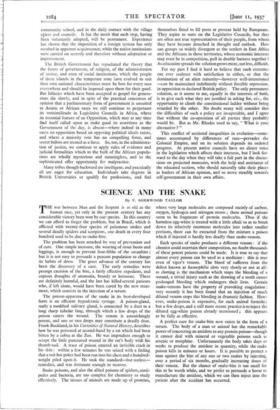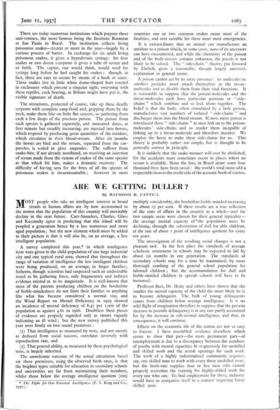SCIENCE AND THE SNAKE
SHERWOOD TAYLOR By F.
THE war between Man and the Serpent is as old as the human race, yet only in the present century has any considerable victory been won by ourvecies. In this country we can afford to forget the problem, but in Brazil, which is afflicted with twenty-four species of poisonous snakes and several deadly spiders and scorpions, one death in every four hundred used to be due to snake-bite.
• The problem has been attacked by way of prevention and of cure. One simple measure, the wearing of stout boots and leggings, is enough to prevent four-fifths of the casualties ; but it is not easy to persuade a peasant population to change its habits of dress. The great advance of the century has been the discovery of a cure. The early remedies were prompt excision of the bite, a fairly effective expedient,- and copious draughts of ammonia, brandy or kerosene. These are definitely harmful, and the last has killed several patients who, if left alone, would have been cured by the new treat- ment, which consists in the injection of a serum.
The poison-apparatus of the snake in its best-developed form is an efficient hypodermic syringe. A poison-gland, really a modified salivary gland, is connected by a duct to a long sharp tubular fang, through which a few drops of the poison enters the wound. The venom is astonishingly potent, and one or two drops may constitute a deadly dose. Frank Buckland, in his Curiosities of Natural History, describes how he was poisoned at second-hand by a rat which had been bitten by a cobra at the Zoo. He was imprudent enough to scrape the little punctured wound in the rat's body with his thumb-nail. A trace of poison entered an invisible crack in his skin : within a few minutes he was seized with a feeling that a red-hot poker had been run into his chest and a hundred- weight piled upon it. He took the standard—but useless— remedies, and was fortunate enough to recover.
Snake poisons, and also the allied poisons of spiders, centi- pedes and bacteria, are too complex for chemistry to study effectively. The tissues of animals are made up of proteins, whose very large molecules are composed mainly of carbon, oxygen, hydrogen and nitrogen atoms ; these animal poisons seem to be fragments of protein molecules. Thus if the harmless egg-white is treated with a little alkali so as to break down its relatively enormous molecules into rather smaller portions, there can be extracted from the mixture a poison which if injected is hardly less deadly than snake-venom.
Each species of snake produces a different venom : if the chemist could ascertain their composition, no doubt thousands of these potent poisons could be made. It is true to say that almost every poison can be used as a medicine : this is true even of viper's venom. The blood of sufferers from the defect known as haemophilia dots very slowly or not at all: as clotting is the mechanism which stops the bleeding of a wound, a trivial injury such as the drawing of a tooth causes prolonged bleeding which endangers their lives. Certain snake-venoms have the property of provoking coagulation : very recently it has been found that an injection of much diluted venom stops this bleeding in dramatic fashion. How- ever, snake-poison is expensive, for each animal furnishes but a few drops, and a still more recent practice is to inject the diluted egg-white poison already mentioned ; this appears to be fully as effective.
A perfect cure for snake-bite now exists in the form of a serum. The body of a man or animal has the remarkable power of concocting an antidote to any protein poison—though it cannot deal with mineral or vegetable poisons such as arsenic or morphine. Unfortunately the body takes days or weeks to produce the antidote in quantity, while the snake poison kills in minutes or hours. It is possible to protect a man against the bite of any one or two snakes by injecting, over a period of six months, gradually increasing doses of their venom. But the chance of snake-bite is too small for this to be worth while, and we prefer to persuade a horse to manufacture the antidote, which we can then inject, into the patient after the accident has occurred. • . There are today numerous institutions which prepare These anti-venines, the most famous being the Institut° Butantan at Sao Paulo in Brazil. The institution collects living poisonous snakes-2o,000 or more in the year—largely by a curious process of barter. In exchange for six adult living poisonous snakes, it gives a hypodermic syringe : for four snakes or two dozen scorpions it gives a tube of serum and so forth. The captor, one would think, would need his syringe long before he had caught his snakes ; though, in fact, these are easy to secure by means of a hook or snare. These snakes live in little white dome-shaped huts erected in enclosures which present a singular sight, swarming with these reptiles, each bearing, as Bohme might have put it, the visible signature of death.
The attendants, protected of course, take up these deadly serpents with complete sang-froid and, gripping them by the neck, make them bite on little flat saucers, so gathering from each a few drops of the precious poison. The poison from each species is gathered separately, and measured doses, at first minute but steadily increasing, are injected into horses, which respond by producing great quantities of the antidote, which circulates in their blood-stream. After six months the horses are bled and the serum, separated from the cor- puscles, is sealed in glass ampoules. The sufferer from snake-bite, if not already moribund, on receiving an injection of serum made from the venom of snakes of the same species as that which bit him, makes a dramatic recovery. The difficulty of having sera for the bites of all the species of poisonous snakes is insurmountable ; however in most countries one or two common snakes cause most of the fatalities, and sera suitable for these meet most emergencies.
It is extraordinary that an animal can manufacture an antidote to a poison which, in some cases, none of its ancestors can have encountered, and while the chemistry of the poison and of the body-tissues remains unknown, the puzzle is not likely to be solved. The " side-chain " theory, put forward by Ehrlich, gives a reasonable, though largely untested, explanation in general terms.
A poison cannot act by its mere presence : its molecules or smallest particles must attach themselves to the tissue- molecules and so disable them from their vital functions. It is reasonable to suppose that the poison-molecules and the tissue-molecules each have particular portions or " side- chains " which combine and so lock them together. The belief is that the body, when stimulated by a little poison, manufactures vast numbers of isolated " side-chains " and discharges them into the blood stream. If, now, more poison is introduced these " side-chains " at once link on to the poison- molecules ' side-chains and so render them incapable of linking up to a tissue-molecule and therefore inactive. We employ the horse to make these side-chains for us. This theory is probably rather too simple, but is thought to be generally correct in principle.
It is unlikely that the snake-menace will ever be abolished, for the accidents thust sometimes occur in places where no serum is available. None the less, in Brazil alone some four thousand lives have been saved : the world's total must add a respectable item to the credit side of the account-book ofscience.

























































 Previous page
Previous page